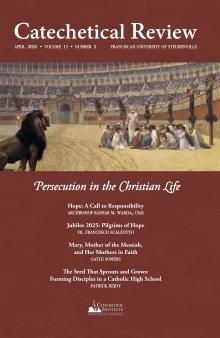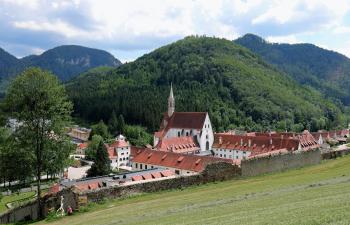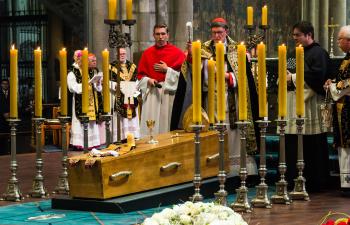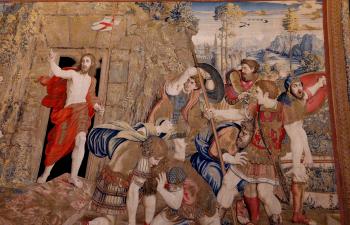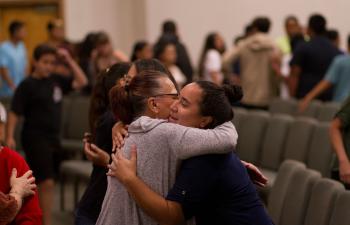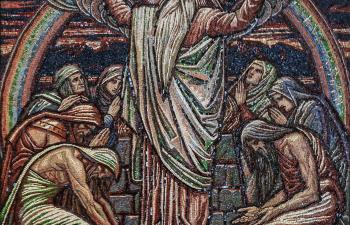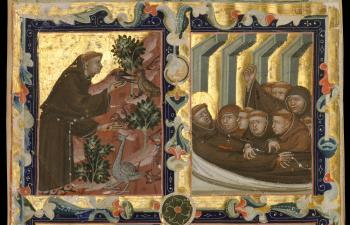 I believe I shall see the LORD’S goodness
I believe I shall see the LORD’S goodness
in the land of the living.
Wait for the LORD, take courage;
be stouthearted, wait for the LORD!
—Psalm 27:13–14
Nothing has gone out of vogue like waiting.
“Buy Now.” Instacart. DoorDash. Prime. No wait: press button and skip line. Our hypertechnical society seems to have finally pushed through what has been a problem for human beings from the beginning. After all, Eve’s doubt in God’s providence, a deep suspicion sown by the cunning serpent, led her to reach out and take matters into her own hands as Adam stood by silently affirming the sinful act. Why wait for the Lord when she could make it happen instantly? We are no different today. Human beings have always hated waiting and have tried to do something about it.
If the Church’s doctrine of purgatory was ever fashionable, it is passé now. Our culture has dismissed hell as an antiquarian, fear-mongering tactic used by religious officials to control people. Meanwhile, humanitarian efforts and good -people-ism have neutralized its threat. And why wait for heaven? We can build our own tech-utopia here! With hell removed from the scene and heavenly decadence on earth, purgatory has no place. We don’t have time for it.
But maybe we should.
Revisiting Purgatory
Death initiates one into an eternal either/or: either heaven or hell. Upon dying, everyone will face a particular judgment and will receive, as the Compendium of the Catechism of the Catholic Church explains, “entrance into the happiness of heaven, immediately or after an appropriate purification, or entry into the eternal damnation of hell.”[1] Hell or heaven. And, indeed, nothing unclean or impure will enter heaven (see Rv 21:27). So, those words from the Compendium—“after an appropriate purification”—cannot be overlooked. Purgatory is that appropriate time, place, and state of purification. “Purgatory is the state of those who die in God’s friendship, assured of their eternal salvation, but who still have need of purification to enter into the happiness of heaven.”[2]
Purgatory is an expression of God’s merciful love. If nothing unclean can enter heaven, then someone who dies with a venial sin is “toast.” If nothing unclean can enter heaven, then the slightest attachment to sin spells tragedy. Unless there is a purgatory. Purgatory is God’s mercy, as time is a mercy. The doctrine of purgatory says the ultimate outcome has already been determined (i.e., heaven), yes, but purgatory is a kind of “overtime” to allow God’s love to continue to transform, purify, and prepare one for heaven. The primary direction and fundamental destiny of one’s life has been determined by the grace of faith, but the ultimate attainment of this destiny requires further purification. As Joseph Ratzinger, who would later become Pope Benedict XVI, explains, “Even if one’s fundamental life-decision is finally decided and fixed in death, one’s definitive destiny need not necessarily be reached straight away. It may be that the basic decision of a human being is covered over by layers of secondary decisions and needs to be dug free.”[3]
The word “purgatory” comes from the Latin word purgare, meaning to make clean, to purify. To purify from what? In short, any attachment to sin. Purgatory purifies one of any venial sin and satisfies temporal punishment. Venial sins are those less serious sins that weaken but do not destroy relationship with God as mortal sin does. Temporal punishment has to do with the temporal consequences due to our sins, the damage that is left behind. Take, for example, my son, who cares for our chickens. If he refuses to wear his boots out to the coop and walks into our house with mud and chicken litter on his shoes, I can forgive him and no longer see him as a disobedient son—but he will still need to clean up the mess on the floor. Another example: I may forgive my four-year-old for slapping his sister with lunch meat (she may forgive him, too), but he still needs to sit in timeout to think about his actions, feel remorse, and amend his ways. Purgatory is a bit like a spiritual timeout.
The rest of this online article is available for current Guild members.
[1] Compendium of the Catechism of the Catholic Church, no. 208; cf. CCC 1022.
[2] Compendium, no. 210; cf. CCC 1030.
[3] Joseph Ratzinger, Eschatology: Death and Eternal Life, 2nd ed., trans. Michael Waldstein (The Catholic University of America Press, 1988), 219.
[4] Ratzinger, Eschatology, 229.
[5] Ratzinger, Eschatology, 231.
[6] Benedict XVI, “Love Itself Purifies [the Soul] from the Dross of Sin,” General Audience, January 12, 2011.
[7] Ratzinger, Eschatology, 231.
[8] Compendium, no. 211; cf. CCC 1032.
[9] Ratzinger, Eschatology, 232.
[10] Ratzinger, Eschatology, 232–33.
[11] O’Connor describes the story as “purgatorial” in The Habit of Being (Farrar, Straus and Giroux, 1979), 577.
[12] Flannery O’Connor, “Revelation,” in The Complete Stories (Farrar, Straus and Giroux, 1971), 499.
[13] O’Connor, “Revelation,” 507.
[14] O’Connor, “Revelation,” 508.
[15] O’Connor, “Revelation,” 508.
Art Credit: Holy Souls in Purgatory, Fr. James Bradley, Flickr.com.
This article is from The Catechetical Review (Online Edition ISSN 2379-6324) and may be copied for catechetical purposes only. It may not be reprinted in another published work without the permission of The Catechetical Review by contacting [email protected]


